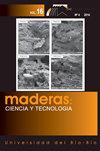Changes in the content and composition of the extractives in thermally modified tropical hardwoods
IF 1.5
4区 农林科学
Q3 MATERIALS SCIENCE, PAPER & WOOD
引用次数: 6
Abstract
Chemical composition of wood is known to change during thermal treatments. Two species grown in Turkey, afrormosia ( Pericopsis elata ) and duka ( Tapirira guianensis ) were heat treated according to Thermowood® method. Lignin, cellulose, hemicelluloses and extractives in dichloromethane, ethanol and water were determined. Wood extracts were analysed by gas chromatography with mass detection and existing compounds were identified by NIST17 database. Results show that hemicelluloses and cellulose content decreased for both heat-treated woods along the treatment while lignin percentage increased. The analysis of extractives has shown several compounds normally associated to lignin thermal degradation that increased along the treatment. At the same time several compounds associated to carbohydrate thermal degradation were found in all the extracts for both heat-treated woods. These founding have allowed the understanding of the degradation pattern of wood during thermal modification. There was not much difference between afrormosia and duka woods structural compounds behaviour along thermal modification. However, the variation of the amount of extractives along the treatment depended on the species. due to water and ethanol extractives. While the extractives increased along the treatment for afrormosia, in duka wood there was an initial increase followed by a decrease with the increase of heating time, which was probably due to the high amount of initial ethanol extractives in duka wood that are degraded along the treatment. The new formed compounds that increased along the thermal modification found in dichloromethane extract are vanillin, syringaldehyde, vanilic acid and syringic acid. For the most severe treatment (2 h), coniferaldehyde, sinapaldehyde and acetovanillone were also detected. All these compounds have been associated to lignin heat degradation showing that although the percentage increases, there is still some lignin thermal degradation. The compounds identified as resulting from lignin degradation in dichloromethane extracts still represent a significant amount in ethanol extracts of both heat-treated woods. Additionally, several other compounds like hydroxy acids, deoxy-pentonic acids, deoxy-hexonic acids γ-lactone and levoglucosan were found in ethanol extract. On heat-treated duka some carbohydrates were also found. All these compounds have been associated to C5 and C6 carbohydrate thermal decomposition. The results have contributed to the understanding of the chemical degradation path of modified wood by monitoring extractive content transfor mations and have shown the importance of optimizing the treatment for each wood species in order to make the best utilization of this material.热改性热带硬木中提取物含量和成分的变化
众所周知,木材的化学成分在热处理过程中会发生变化。根据Thermowood®方法,对生长在土耳其的两种植物,afrormosia (periopsis elata)和duka (Tapirira guianensis)进行热处理。测定了木质素、纤维素、半纤维素和萃取物在二氯甲烷、乙醇和水中的含量。采用气相色谱质谱法对木材提取物进行分析,通过NIST17数据库对化合物进行鉴定。结果表明,两种热处理木材的半纤维素和纤维素含量随处理时间的增加而降低,木质素含量随处理时间的增加而增加。对萃取物的分析表明,几种通常与木质素热降解有关的化合物随着处理而增加。同时,在两种热处理木材的所有提取物中都发现了与碳水化合物热降解有关的几种化合物。这些发现使我们能够理解木材在热改性过程中的降解模式。在热改性过程中,非洲木和杜卡木结构化合物的性能没有太大差异。然而,随着处理的进行,提取物的量的变化取决于物种。由于水和乙醇的萃取。随着黑霉处理的进行,提取物的含量逐渐增加,但随着加热时间的增加,杜卡木材的提取物含量先增加后减少,这可能是由于杜卡木材中大量的初始乙醇提取物在处理过程中降解所致。在二氯甲烷萃取物中发现了随着热改性而增加的新形成的化合物有香兰素、丁香醛、香草酸和丁香酸。在最严重处理(2 h)时,还检测到松柏醛、sinap醛和乙酰香草酮。所有这些化合物都与木质素热降解有关,表明尽管百分比增加,但仍有一些木质素热降解。经鉴定为由二氯甲烷提取物中木质素降解产生的化合物在两种热处理木材的乙醇提取物中仍然具有显著的量。此外,在乙醇提取物中还发现了其他几种化合物,如羟基酸、脱氧戊酸、脱氧己酸γ-内酯和左旋葡聚糖。在热处理过的杜卡上也发现了一些碳水化合物。所有这些化合物都与C5和C6碳水化合物的热分解有关。这些结果有助于通过监测提取物含量的变化来了解改性木材的化学降解途径,并表明了优化每种木材的处理以最大限度地利用这种材料的重要性。
本文章由计算机程序翻译,如有差异,请以英文原文为准。
求助全文
约1分钟内获得全文
求助全文
来源期刊

Maderas-ciencia Y Tecnologia
工程技术-材料科学:纸与木材
CiteScore
2.60
自引率
13.30%
发文量
33
审稿时长
>12 weeks
期刊介绍:
Maderas-Cienc Tecnol publishes inedits and original research articles in Spanish and English. The contributions for their publication should be unpublished and the journal is reserved all the rights of reproduction of the content of the same ones. All the articles are subjected to evaluation to the Publishing Committee or external consultants. At least two reviewers under double blind system. Previous acceptance of the Publishing Committee, summaries of thesis of Magíster and Doctorate are also published, technical opinions, revision of books and reports of congresses, related with the Science and the Technology of the Wood. The journal have not articles processing and submission charges.
 求助内容:
求助内容: 应助结果提醒方式:
应助结果提醒方式:


